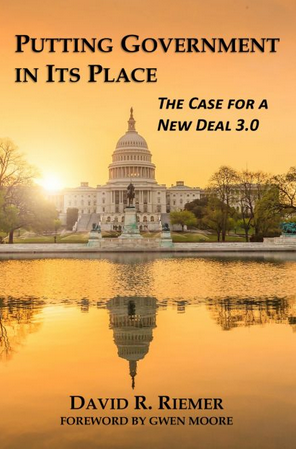A New Design for American Government
American government suffers from major design flaws. Only a new design will get the United States back on track.
The current model of government worked tolerably well during the first few decades that followed the end of World War II.
The essential building blocks of that "old normal," however, vanished years ago. America's post-war nearly total domination of the world economy is history. Government policies which further invigorated the domestic economy in the wake of the original New Deal--such as the GI Bill and Interstate Highway Program--have lost their steam.
Fundamental reform is the design of American government is no longer an option. It is a necessity.
It is sometimes tempting to tinker at the margins. Sweeping reform can be scary. It is certainly hard work. It is easy to shy away from designing a new model. But if we really want American government to succeed in achieving its fundamental purposes, we dare not be timid.
We need instead to channel the spirit of FDR, be candid about both the underlying strengths and the enormous weaknesses of the New Deal writ large, and create a bold new design for American government.
Creating the design requires five steps.
First: Government as Stage
First: It is essential to start with a central, unifying story that guides all aspects of the new design. Already discussed in a prior section, the central story proposed here is to re-envision government as a public stage.
We should see government as a strong, enduring, but neutral platform that provides a foundation: a foundation of (1) public safety, health, resources, and infrastructure; (2) economic security and equal opportunity; and (3) an effective national market.
Atop this solid stage, government's role should be strictly limited, next to non-existent. Individuals and firms would write the script and do all the acting. Unimpeded by government and unsteered by politicians, the American people--individually and through private organizations--would control the direction and shape of the U.S. economy and culture.
Second: Coherent Design Principles
It is equally important to build reform on top of a solid foundation of coherent, consistent, linked-up principles. The proposed public stage would be constructed based on ten design principles.
Third: Focus on Freedom
All elements of the new design should point to, and help build, the value and the outcome that Americans most deeply cherish: freedom. This focus on freedom applies to individual freedom; cultural freedom; and (consistent with protection of the environment, workers, consumers, and investors) market freedom.
The ultimate test of the reform's success will be whether it bring America to its next birth of freedom.
Fourth: A New System of Economic Security
The heart of a new design of American government has to be a much stronger system of economic security and equal opportunity. The current inadequate system is our greatest shortcoming, and the greatest impediment to American freedom.
Details follow in a subsequent section. Here is simply an outline of what the new structure of economic security and equal opportunity would do:
- Offer wage-paying Transitional Jobs to the unemployed and underemployed;
- Raise the minimum wage to at least $10 per hour;
- Absorb the Earned Income Tax Credit and Child Tax Credit into a new, bigger, reformed earnings supplement, so that full-time work always yields an income well above the poverty line, but workers no longer face a disincentive to work or marry;
- Make it easier to organize unions and bargain collectivelyfor better wages and benefits;
- Boost the incomes of adults who fall outside the labor market--whether because they cannot work due to a serious disability, or have retired from work as seniors--so they, too, live comfortably above the poverty line;
- Provide all Americans with excellent health insurance choices from a wide range of top-notch health care plans, using incentives to control cost, improve the quality of care, and advance better health outcomes; and
- Offer child care at no cost, make sure every K12 student has the resources needed to get an excellent education from a wide choice of carefully overseen schools, and make higher education tuition-free and debt-free.
An effective way to deliver this new system would be to provide every American with an Individual Progress Portfolio that provides a mechanism for accessing all of the system's components in a way that is transparent, joined-up, high-tech, easy to navigate, and above all empowering.
At the same time that we put these policies in place, we should abolish all poverty-requiring, “means-tested” welfare programs.
Fifth: An Effective Market
Finally America deserves an effective market. Creating a truly free market--free of cost "externalization" and subsidies for politically-favored types of consumption and investment--will expand the overall freedom of the American people and their economy, as well as market the economy more productive and wealthier. " A subsequent section provides details, but the broad outline is simple
An effective market requires fully protecting the environment, workers, investors, and consumers from harm and undue risk, thus blocking the “externalization” of costs by firms that don't want to compete on a level playing field.
An effective market also requires abolishing subsidies for agriculture, energy, housing, and transportation, and all other politically favored types of consumption and investment. Subsidies should be eliminated whether they are embedded in the tax system, emerge as direct spending, or involve tax support for utilities such as the road system.


